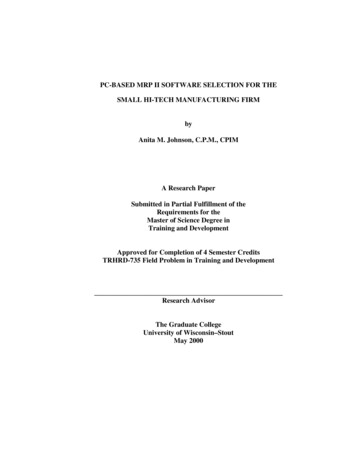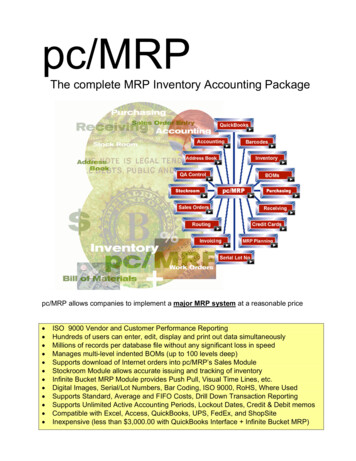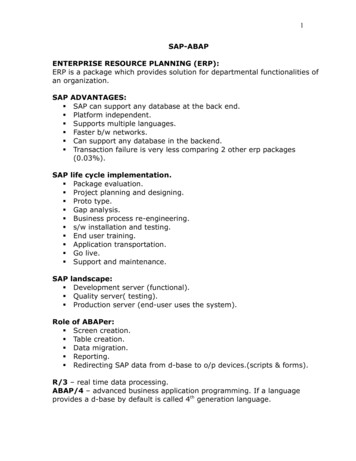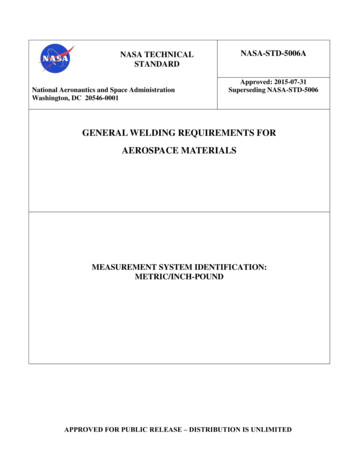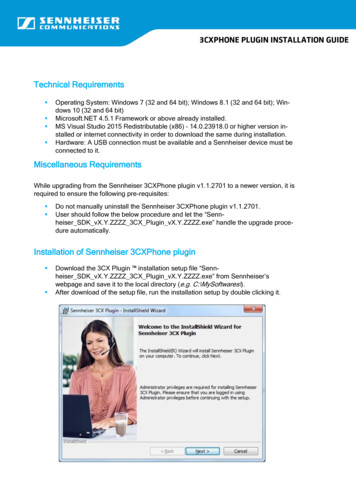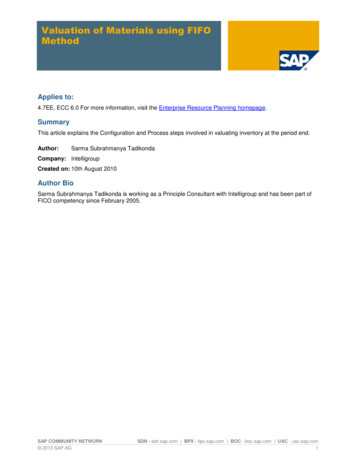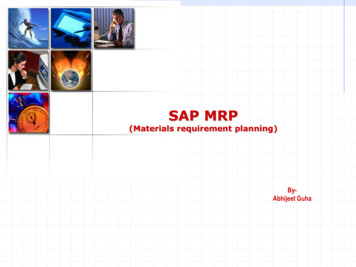
Transcription
SAP MRP(Materials requirement planning)ByAbhijeet Guha
Topics1What is MRP2Master data for MRP3MRP Procedures4Planning Process5Lot sizing Procedure6Traffic lights7ATP (Available to Promise)
What is MRP.The main objective of MRP is to guarantee material availability.MRP is required to procure or produce the required quantities ontime for internal purpose or for SALES.WHY MRP ? Optimizing service level Minimizing costs and capital lockup.
MRP can be done in several ways:MRP at plant or MRP Area level With MRP at plant level, the system considers stocks from the storage locations withinthe plant, excluding the stocks already reserved. In case of MRP area level, the stocks from the storage locations belonging to this MRParea as defined can be taken for planning to generate the requirements. MRP area planning helps in cases where one wants to restrict the planning to certainstorage locations.Lot-Sizing and MRP ProceduresDifferent lot sizing can be combined with different MRP’s.Automatic Planning Run This is done automatically wherein the requirements are generated. The system generates messages in case of critical situations which can be addressedlater after the run.
Process ntIndependentrequirementsSD ProcessingPlanned orderConversionCAPACITY PLANNINGPurchaserequisitionProduction OrderSchedulingAgreementPurchasingfunctionsOrder ProcessingPurchase OrdersFINAL COSTINGINVOICE VERIFICATIONWarehouse
Process flowchart
MRP Process flowS & D gives concrete customer requirements from the market.In Demand Management, sales are planned in advance via a sales forecast. Theresult is the independent requirement, i.e., the requirement for the finished product.In order to cover these requirements, MRP runs and calculates procurementquantities and dates as well as plans the corresponding procurement elements.If a material is produced in-house, the system also calculates the dependentrequirements, that is, the quantity of components required to produce the finishedproduct or the assembly, by exploding the BOM. If a material shortage exists,planned orders are created at every BOM level to cover requirements.Production orders or Purchase orders are created.
Topics1What is MRP2Master data for MRP3MRP Procedures4Planning Process5Lot sizing Procedure6Traffic lights7ATP (Available to Promise)
Master data for MRPThe following elements are required for MRP: Material masterBills of materialWork centre ( in-house production)Routings ( in-house production)Demand managementSales and distribution (optional)
Topics1What is MRP2Master data for MRP3MRP Procedures4Planning Process5Lot sizing Procedure6Traffic lights7ATP (Available to Promise)
MRP ProceduresMaterial requirements planningMaster production schedulingConsumption based planning
Material requirements planning1.It uses current and future sales figures.2.The system calculates the requirements based on the warehouse stock,receipts, etc.3.If externally procured then procurement proposals; if internal productionthen it leads to creation of planned orders, and also dependentrequirements are calculated.4.The best thing about this is that it leads to minimization of inventory,which leads to reduction of costs involved.
Master production scheduling1.It is for used specifically for critical resources.2.A separate run occurs for the MPS items, they are not included in theMRP run.3.Basically, it ensures the availability of the critical resources which shouldnot hamper the production by maintaining the stock4.It also provides the facility to work on the production plan interactively.
Master production scheduling
Consumption based planning1.It uses the past consumption data to calculate the future requirements.2.It has no relation with the independent or dependent requirementinstead it is triggered when the stock falls below the reorder point or byforecast requirements.It has three types of MRP procedures: Re-order point planning.Forecast based planning.Time phased planning.
Re-order Point Planning Procurement is triggered when the sum of plant stock and firmedreceipts fall below the reorder point. Reorder point covers the material requirements during replenishmentlead time. The safety stock takes care of both excess material consumption withinthe replenishment lead time and any additional requirements that mayoccur due to delivery delays
Re-order Point PlanningRe-order point is defined by : Safety stock Replenishment lead time. Average consumption.Safety stock is defined by : Past consumption data.Vendor/ production delivery timelines.Service level.Forecast error.
Re-order Point Planning
Re-order Point Planning Manual Reorder point planningFormula (procurement processing time planned delivery time GRprocessing time) Safety stock Automatic reorder point planning
Brief of some MRP TypesSome of the major types:MPSM0– MPSMRPPD– MRPTime phasedR1– Time-phased planningR2– Time phased w. auto.reo. ptConsumption basedV1– Manual reorder ptV2– Auto. reorder ptVV– Forecast based planning
Forecast based planning It is also based on historical data, or the past material consumption data. Here the forecast values form the basis of the planning run. Based on the consumption pattern the system changes the forecastrequirements for future.
Time phased planning1.This is used specially in case if the planning cycle is known.2.The materials planned using this is given an MRP date in the planningfile.3.This date is set when creating the material
Planning file1.The Planning file contains the details of the materials that are to beincluded for the MRP run.2.MRP is to be activated for the plant, an entry for the material is to bemade in the planning file for the specific plant for the MRP to happen.3.MRP Run for a material occurs taking the information from the planningfile.T-Code for creating planning file MD20& in the background MDABActivate MRP & setup planning OMDUfile
Planning run typePlanning run type depends on the processing key in the MRP run screenThere are three types of processing key— NETCH (Net change planning in total horizon)NETPL (Net change planning in the planning horizon)NEUPL (Regenerative planning)
Planning Run Type- NETCH1.In this run, the system considers those materials in the planning runfrom their last MRP run in the total horizon.2.But then it depends if there was any change inChange in stock.Creation of PR’s; PO’s; etc.Any changes pertaining to receipts & issues.
Planning Run Type- NETPL1.In this run, the system considers those materials in the planning runwhich have undergone any change in the planning horizon as defined.2.Here the number of materials to be taken for MRP Run can berestricted by defining the planning horizon.
Planning Run Type- NEUPL1.It plans all the materials for the MRP Run irrespective of the changesthey undergo.2.This plan is not so widely used. It takes a long time to obtain thefinal result.
MRP 1
MRP 2
MRP 3
MRP 4
Topics1What is MRP2Master data for MRP3MRP Procedures4Planning Process5Lot sizing Procedure6Traffic lights7ATP (Available to Promise)
Planning Process The system checks the planning fileThe system calculates the net requirements for every material.The system calculates procurement proposals.Scheduling happens.The system determines the type of procurement proposals.During MRP run, the system checks some critical situations which need tobe worked manually and hence it creates exception messages.Planning can also happens at: Storage location MRP Areas Multi Plant/Site planning
Planning Run It can be run for a plant, group of plants, an MRP area, or several MRPareas. For a single material or product group.Planning run can be: Total planningSingle-item, single level planningMulti-level, single item planningInteractive planningMulti-level, make-to-order productionIndividual project planningThe system creates procurement proposals which can be planned orders,purchase requisitions, schedule lines.
Planning time fence & planning horizon This is specially useful in case of MPS scenario where one can save theprocurement proposals from undergoing any change since the lastplanning run. No automatic changes happen to the procurement proposals once theyenter in the planning time fence. Planning horizon is the period in which the materials which haveundergone any changes are taken into MRP run.
Stock requirement list (T-Code—MD04)
Create PIR (T-Code—MD61)
Create PIR
Stock requirement list after creating PIR
MRP RUN (T-Code—MD02)
MRP RUN Output
Stock requirement list after MRP Run
Topics1What is MRP2Master data for MRP3MRP Procedures4Planning Process5Lot sizing Procedure6Traffic lights7ATP (Available to Promise)
Lot Sizing Procedure Lot Sizing procedure gives the quantity either to be procured or to beproduced. This can be defined in the lot sizing procedure in customizing for MRPin Check Lot-sizing procedure OR directly can be defined usingT-code – OMI4.Three groups of Lot Sizing procedures are available :--1.2.3.Static lot-sizing proceduresPeriod lot-sizing proceduresOptimum lot-sizing procedures
Lot Sizing Procedure
Static Lot Sizing Procedure In this, the procurement quantity is calculated based on thespecifications mentioned in the material master. The different procedures in this are:1.2.3.4.Lot for lotFixed lot sizeFixed lot size with splitting & overlappingReplenishment up to maximum stock level.
Period Lot Sizing Procedure In this, the system groups the requirements in the defined period andcreates a lot. The period can be defined in days, weeks, months, periods of flexiblelength equal to posting period, freely definable periods according toplanning calendar. Splitting and overlapping can also be done. The system sets the availability date to the first requirement date withinthe period, or the availability date can be set either at the beginning orat the end of the period.
Optimum Lot Sizing Procedure In the static or period lot sizing, the cost are not taken intoconsideration. Here the requirements are grouped together in a way which will reducethe cost.
Topics1What is MRP2Master data for MRP3MRP Procedures4Planning Process5Lot sizing Procedure6Traffic lights7ATP (Available to Promise)
Traffic lights
Traffic lights Materials are defined by traffic lights in the stock requirement list toindicate the urgency of the materials to be processed. Traffic lights can be defined based on the ranges of coverage andexception groups which can be customized based on the priority. To define the traffic light, go to stock requirement list (MD04), thenpush the overview tree button at the top left corner, it will show thetraffic lights against the material. Right clicking the traffic light will popup the dialog screen where-in the ranges of coverage and exceptiongroup can be defined.
Topics1What is MRP2Master data for MRP3MRP Procedures4Planning Process5Lot sizing Procedure6Traffic lights7ATP (Available to Promise)
ATP (Available to Promise)1.During ATP, the system checks that all issues are covered by existingreceipts2.Hence, if any quantities are left to cater new issues. This is ATPQuantity.
ATP (Available to Promise)It can be done at various stages, in the business:At Sales and distribution When creating the Sales order, availability checkis carried to know whether the delivery can be done at the required date.Planned order processing When converting a planned order into aproduction order, to know the material availability to fulfill the productionorder.Production order processing When processing production orders, to knowthe material availability.Inventory Management When changing reservations, or doing goodsissue, an availability check can be done to know whether it can fulfill therequirement and also whether it affects the availability of other elements.
ATP (Available to Promise)ATP calculation is as follows:The receipts (warehouse stock, planned orders, purchase requisitions) aredynamically allocated to the issues (customer requirements, PIR’s,reservations), which lie directly after them on the time axis. Thecalculation is carried out in such a way that the issue is allocated to thereceipt that lies nearest to it and that still has a positive ATP quantity.If the ATP quantity of this receipt does not cover the issue then the systemwill search for and check the next nearest receipt (always in abackwards direction) for a positive ATP quantity, which will then also beallocated to the issue.If receipts do not cover the issue, you must then decide whether you reducethe requirements quantity as necessary or whether you move therequirements date so that requirements coverage can be reachedagain.
Availability checkAvailability Check at Plant Level
Availability checkAvailability Check at Storage Location Level
Availability checkAvailability Check at Batch LevelIf only one batch is entered, the check is carried out on two levels, firstagainst the batch and then against the plant stock.If a batch and a storage location are entered, the check is carried out onfour levels, first against the batch storage loc ation, then against thebatch, the storage location and the plant stock.Availability Check for Individual Customer Stocks and Project StocksIndividual customer stocks and project stocks are maintained separately inthe system and are not contained in plant stock. If an issue is madefrom individual customer stock or project stock, the availability ischecked only for this particular customer stock.
In Demand Management, sales are planned in advance via a sales forecast. The result is the independent requirement, i.e., the requirement for the finished product. In order to cover these requirements, MRP runs and calculates procurement quantities and dates as well as plans the corresponding procurement elements. If a material is produced in-house, the system also calculates File Size: 1MBPage Count: 58


